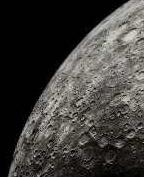Mercury: Too Hot AND Too Cold
 Almost our smallest planet, Mercury is just a bit larger than the
Moon. It's a LOT heavier, though. The mostly iron core makes up
nearly the entire planet. Almost all of our information about
Mercury comes from
one spacecraft, Mariner 10. It flew by three times in 1974 and
1975. Only 45% of the surface was mapped. A new mission to Mercury
has been recently approved. MESSENGER launched August 3rd, 2004
and will orbit Mercury in 2011.
Almost our smallest planet, Mercury is just a bit larger than the
Moon. It's a LOT heavier, though. The mostly iron core makes up
nearly the entire planet. Almost all of our information about
Mercury comes from
one spacecraft, Mariner 10. It flew by three times in 1974 and
1975. Only 45% of the surface was mapped. A new mission to Mercury
has been recently approved. MESSENGER launched August 3rd, 2004
and will orbit Mercury in 2011.
 Orbit of Mercury
Orbit of Mercury
Mercury's orbit is highly eccentric; at perihelion it is
only 46 million km from the Sun but at aphelion it is 70 million. The
perihelion of its orbit precesses around the Sun at a very slow rate.
Mercury rotates three times in two of its years (a Mercury year
is 88 earth days). The time between subsequent sunsets is TWO
Mercury years! Mercury is the only body in the solar system
known to have an orbital/rotational resonance with a ratio other
than 1:1. This resonance is due to the tidal force of the Sun
on Mercury (like the tidal-lock Earth has on the Moon).

Precession of Mercury's Orbit
Newton's Law of Universal Gravitation had a flaw! Mercury's orbit is
elliptical, as predicted by Newton's theory of gravity, but the
ellipse doesn't stay in precisely the same place all the time. It
precesses: as Mercury orbits the sun, the entire ellipse rotates
about the focal point (i.e. the sun).
Einstein showed that the nearby very massive Sun disturbs the orbit of Mercury in a way unpredicted by Newton's Gravitation Law. How? Mercury's eccentric orbit periodically moves it into a stronger and then a weaker gravitational field, where it encounters a different space-time curvature. (Sorry you asked?)
 Surface of Mercury
Surface of Mercury
Mercury actually has a very thin
atmosphere consisting of atoms blasted off its surface by the solar wind.
However, because Mercury is so hot, these atoms quickly escape into space.
Due to its lack of atmosphere and close proximity to the Sun, temperature
variations on Mercury are the most extreme in the solar system ranging from
90 K to 700 K.
The surface of Mercury exhibits enormous escarpments, called lobate scarps, some up to hundreds of kilometers in length and as much as three kilometers high. They cut through rings of craters and other features indicating that they were formed by compression, wrinkling the surface. It is estimated that the surface area of Mercury shrank by about 0.1% (1 km in radius) when the planet cooled.
Caloris Basin is the largest known feature on Mercury's surface (seen above left). It is similar to the large basins (maria) on the Moon. Like the lunar basins, it was caused by a very large impact early in the history of the solar system. The dense crowding of craters indicates the surface is extremely old, having lived through an early intense bombardment phase between 4.5 and 4.0 billion years ago.